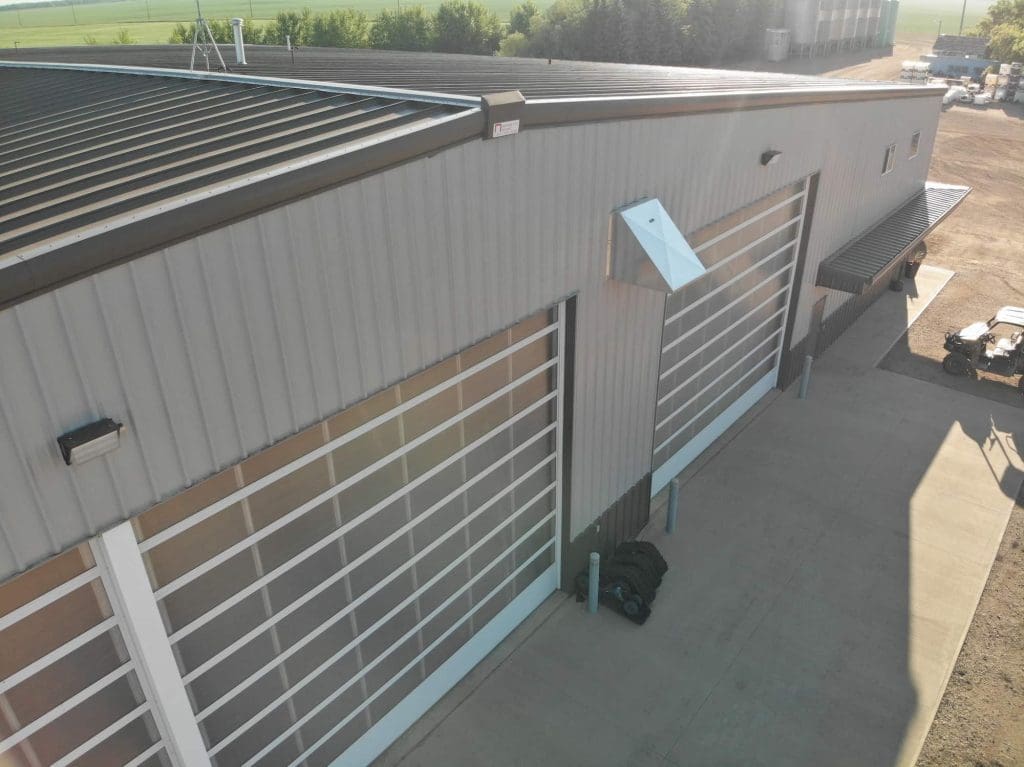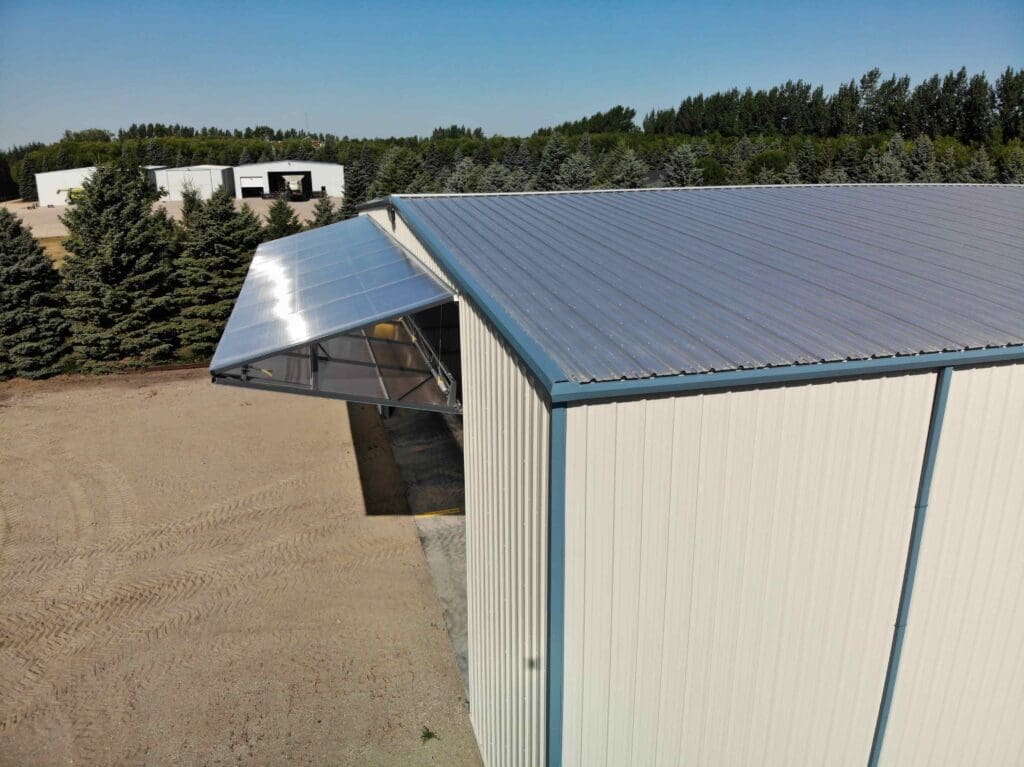The Best Door For a Metal Building: 4 Popular Options
Planning a steel building? One of the big decisions is your type of door. Some of the most popular types of large commercial doors include: overhead mullion doors, bi-fold doors, hydraulic doors, and fin doors. Below we compare each to get a better sense of which is right for your project.
Table of Contents
Overhead Mullion Doors


Overview
Overhead mullion doors are characterized by vertical bars (mullions) that divide the door into sections, typically found in storefronts, warehouses, and manufacturing facilities.
Benefits
- Versatility: Mullion doors can be customized to fit various sizes and configurations, making them suitable for a range of commercial applications.
- Security: The vertical mullions add structural strength, enhancing security against unauthorized access.
- Aesthetics: They offer a sleek, modern appearance that can improve the overall look of a building.
- Natural Light: Mullion doors often incorporate glass panels, allowing natural light in and reducing the need for artificial lighting during the day.
- Cost-Effective: Generally, they’re more affordable compared to some high-tech alternatives, making them a cost-effective choice for many businesses.
Disadvantage
Insulation Challenges: The additional joints and gaps around the mullions can make it more challenging to achieve effective sealing and insulation. This can result in drafts and reduced energy efficiency compared to solid doors.
Bi-Fold Doors


Overview
Bi-fold doors consist of panels that fold back on themselves, creating a compact footprint when opened. These doors are commonly used in airplane hangars, fire stations, and industrial buildings.
Benefits
- Space Efficiency: Bi-fold doors fold neatly, maximizing usable space both inside and outside the door opening.
- Quick Access: They open and close quickly, providing rapid access and minimizing wait times for vehicles and equipment.
- Durability: Bi-fold doors are built to withstand heavy usage and harsh environmental conditions, ensuring long-term reliability.
- Large Openings: They can cover wide openings, making them ideal for large-scale operations that require large entry and exit space.
- Customization: Available in various materials and finishes, bi-fold doors can be tailored to meet specific aesthetic and functional requirements.
Disadvantage
Upfront Costs: Bi-fold doors can be more expensive to purchase and install than simpler door types due to their complex design and the materials required.
Hydraulic Doors


Overview
Hydraulic doors operate using hydraulic cylinders to lift and lower the door, commonly seen in agricultural buildings, aviation facilities, and industrial applications.
Benefits
- Smooth Operation: Hydraulic systems provide smooth and controlled opening and closing, reducing wear and tear on the door mechanism.
- Strength and Stability: Hydraulic doors are robust and can support large spans and heavy loads, making them suitable for high-traffic areas.
- Weather Resistance: These doors offer excellent sealing against wind, rain, and snow, improving energy efficiency and interior climate control.
- Safety: Equipped with advanced safety features such as sensors and automatic stops, hydraulic doors ensure safe operation for personnel and equipment.
- Minimal Maintenance: With fewer moving parts compared to other types of doors, hydraulic doors require less frequent maintenance, saving time and money.
Disadvantage
Electrical Power Dependence: Hydraulic doors require a reliable power source to operate the hydraulic pump. In the event of a power outage, the door may become inoperable unless a backup power system, such as a generator, is in place. This dependency can be a critical issue in areas prone to power interruptions.
Fin Doors


Overview
Fin doors feature panels that move horizontally and are typically used in specialized industrial settings and high-security environments.
Benefits
- Security: The robust design and horizontal operation make fin doors highly secure, deterring unauthorized access and providing a strong barrier.
- Compact Design: When open, fin doors occupy minimal space, allowing for unobstructed movement around the door opening.
- Energy Efficiency: Well-insulated fin doors can help maintain stable interior temperatures, contributing to lower heating and cooling costs.
- Customizable: Fin doors can be designed with various materials, finishes, and insulation levels to suit specific operational and aesthetic requirements.
Disadvantage
Maintenance Requirements: Fin doors can require regular maintenance to keep the fins or slats clean and free from debris. Dust, dirt, and other particles can accumulate between the fins, affecting the door’s appearance and potentially its operation.
Conclusion
Each type of large commercial door—overhead mullion, bi-fold, hydraulic, and fin—offers distinct advantages that cater to different needs and applications.
- Overhead mullion doors excel in versatility, aesthetics, and cost-effectiveness.
- Bi-fold doors are ideal for space efficiency, quick access, and durability.
- Hydraulic doors provide smooth operation, strength, and minimal maintenance.
- Fin doors maximize space, security, and energy efficiency.
Selecting the best door for a metal building will require you to keep in mind the unique requirements of your facility, including space constraints, security needs, environmental conditions, and budget.
For more detailed specifications and custom solutions, consult with a trusted supplier to find the best option for your business.
